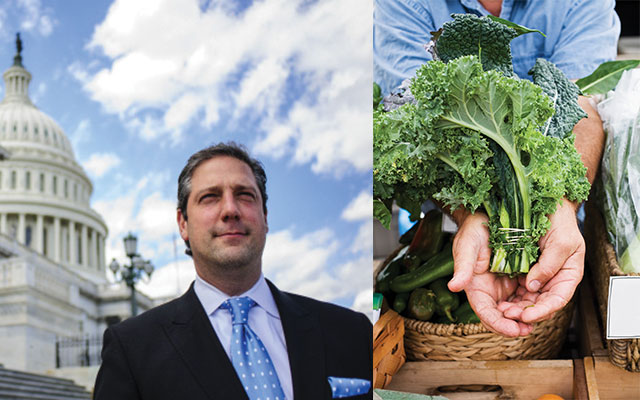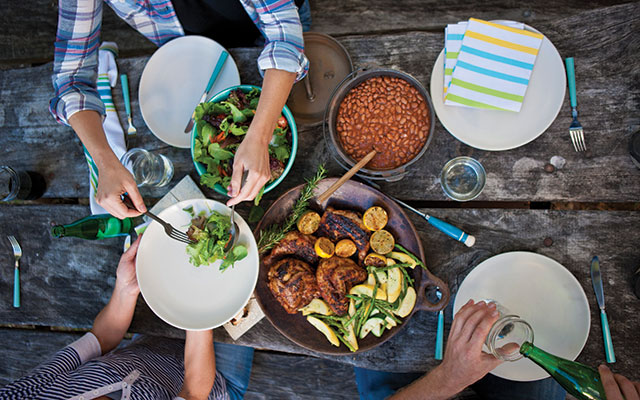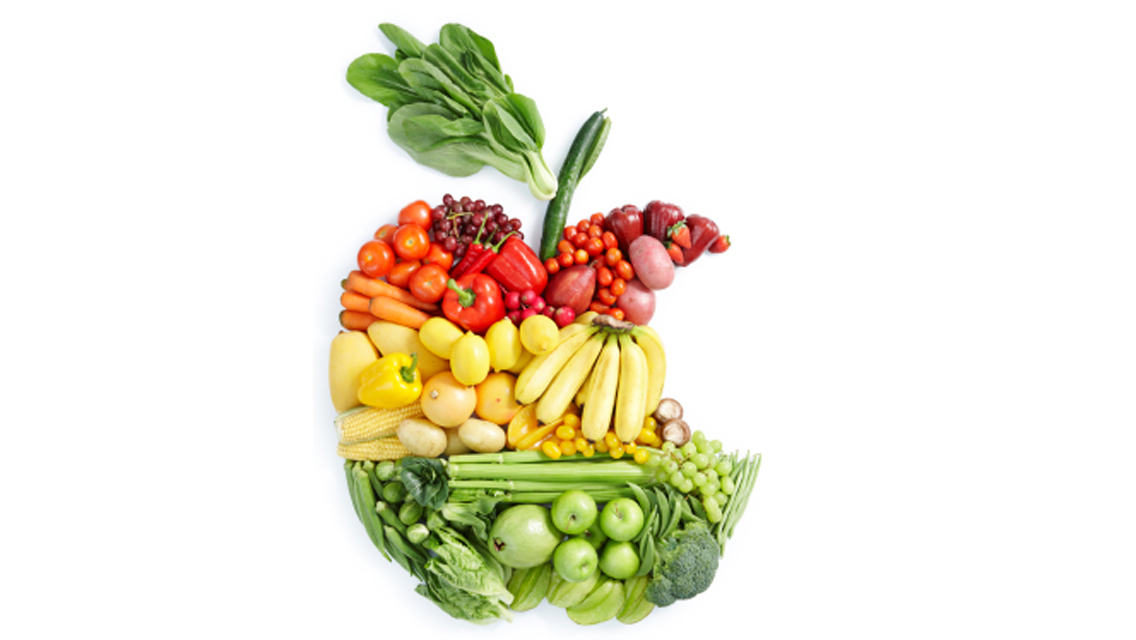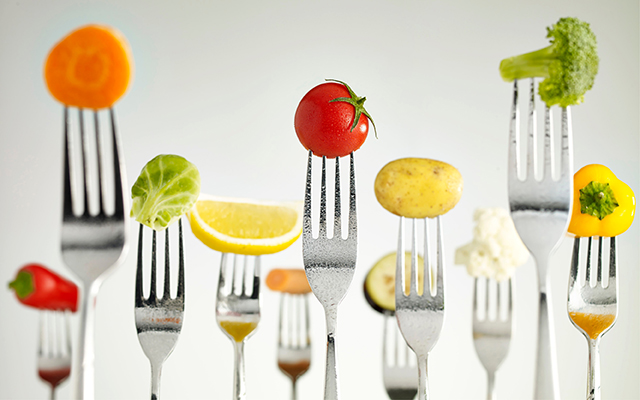Hello. My name is Tim Ryan, and I am addicted to chicken wings and ice cream.
Ask anyone — my wife, my friends, my acquaintances. We can finish a huge meal, and a half hour later I’ll crave Buffalo chicken wings just to wrap up the night.
I share this because I want you to know that I am not a purist. I am not an absolutist or an extremist. I love food and lots of different kinds of food. I go on different diets and then I cheat.
Every week I try to watch what I eat — to be good, so that at some point I can be bad. But I have, slowly and over time, moved myself in the direction of healthier eating. I have started to pay more attention, especially now that I am married with two stepchildren and a newborn.
My wife and I have both experienced personal, food-related health setbacks (see “Andrea’s Story, below”). And as a member of the United States Congress, I have also seen many public health setbacks as our government continues policies and strategies that make eating bad food or fake food the most convenient option.
I’m guessing you know what I mean by “fake food.” In fact, I saw some just a few minutes ago at the checkout counter when I was buying some sticky notes and printer paper at Staples. (Yes, we buy food at office-supply stores these days. Go figure.) It was a package of super-stuffed cheese-cracker sandwiches. There was nothing in it that resembled what my grandparents would have called “cheese,” however.
The top ingredients were high-fructose corn sweetener, soy oil, processed flour, and then the usual bunch of unpronounceable ingredients to make the snack look more appealing, and to preserve it beyond the year my 10-year-old daughter graduates from college.
We Americans love this fake food. We must, because the Fortune 500 companies behind these tasty snacks and prepared meals earned $439 billion in 2012.
Unfortunately, I’m not at all sure fake food loves us back.
So, why does this matter to a U.S. congressman? It matters because cheap, convenient food is costing us a lot in healthcare dollars. And because one of our most important resources — our food supply — which we require to be a dynamic, innovative country, is broken.
Consider these statistics:
- 35 percent of American adults are obese.
- More than a third of our children are overweight or obese.
- Obesity has more than doubled in children and quadrupled in adolescents in the past 30 years.
- In 2012, 15 percent of American households — that’s 49 million people — were “food insecure,” meaning they didn’t have consistent access to nutritionally adequate food on a daily basis.
Simply put, whether it’s obesity, food insecurity, or other negative health outcomes from poor nutrition, the majority of Americans are ill-served by our current food system.
The kind of food we get and how we get it matters because we have come to the point where the government is effectively “prescribing” a diet for Americans — and then prescribing medicine to follow our meals, because the diet is making enough people unwell that they require expensive medication to compensate.
It is your tax dollars that are making fake food cheap. Yes, I said it.
Hardworking families try to make ends meet while also meeting their societal obligations by paying taxes. And what does Congress do with that money? It subsidizes the fake-food industry so the products are cheap and easily accessible to everyone.
The massive payments we make to “support” our food system go largely to big producers of corn, soy, and wheat (the feedstock for so much fake food).
The massive payments we make to “support” our food system go largely to big producers of corn, soy, and wheat (the feedstock for so much fake food).
At the same time, very little goes to smaller, regional farmers producing diversified crops, including fruits and vegetables, in more sustainable and humane ways.
So then we eat all that fake food, get sick, and need healthcare, which is often funded by the government, too.
So we pay to make cheap food, and then we pay to heal people who eat that cheap food. It doesn’t make a lot of sense.
The Scary Side of Convenience
The other day, while driving through the countryside, I counted 14 fast-food outlets, all with full parking lots. I stopped and picked up a local paper. There were flyers from four different food stores advertising their weekly specials. I counted:
- 47 sales on soda and sugary drinks
- 41 sales on pastries, cookies, and candy
- 47 sales on snack foods and sugary cereals
There were also sales on meat, vegetables, and fruit, but the packaged, processed foods dominated the pages.
I haven’t become a food snob; I’ve eaten plenty of these processed foods in my time and, every once in a while, I still do. But as I look at the food environment my children are growing up in, I’m increasingly concerned.
When I visit schools and see a child eating Twinkies or Fruit Roll-Ups and washing it down with soda pop for lunch, I wonder, How can they ever learn about healthy food? How can they learn about good nutrition that will help keep them physically and mentally fit?
Few schools have a curriculum for nutrition. Meanwhile, TV is bombarding kids with enticements to eat poorly and they are surrounded by examples of people eating with little concern for nutrition or long-term health consequences. It may be hard for us adults to change what we buy for our kids and how we eat, but we have to, for the sake of the next generation.
What have years of the modern way of eating done to us? Since the 1960s, the weight of the average American has gone up 20 pounds, while the average height is only an inch taller. It’s no wonder, because on average we’ve been consuming 70 pounds of sugar a year and 500 more calories a day than we did in the 1970s.
On average we’ve been consuming 70 pounds of sugar a year and 500 more calories a day than we did in the 1970s.
We’re often eating on the run, and we spend the lowest percentage of our household budgets (only 7 percent) on eating at home of any major country in the world. The USDA reports that four out of five adolescents have at least one snack a day, with snacks accounting for a quarter of their total daily calories.
Because we are not taking time to have leisurely family dinners, many doctors, nutritionists, and cooks believe we are not adequately savoring our food, meaning we’re not giving ourselves the opportunity to realize when our appetites are satisfied. And in the end, this means we eat more.
Advocates for Slow Food assert that we also have a hard time feeling satisfied because our industrialized food simply doesn’t have the taste and aroma it once did. It doesn’t provide the natural feast for the senses that has been an essential part of eating, and a key part of our American melting-pot food traditions, for a very long time.
Our industrial food may not provide much in the way of satisfaction or nourishment, but what it does provide is lots of sugar, unhealthy fats, salt, and chemicals that drive cravings.
According to Barry Popkin, PhD, professor of nutrition at the Carolina Population Center at the University of North Carolina at Chapel Hill, three-quarters of all our food and beverages now have sugar added to them.
And there’s no shortage of variety. Popkin points out that we’ve gone from having 15,000 food-product bar codes in the early 1980s to 600,000 bar codes today — and most of it is packaged-food goods, the junk food that makes up half of the grocery store. And as I said, you can buy that sort of food almost anywhere now.
To make matters worse, we don’t limit ourselves to just three meals a day. We’ve become a nation of perpetual snackers, taking in something like five or six eating events a day — often featuring sweets.
In his book Salt Sugar Fat: How the Food Giants Hooked Us, author Michael Moss notes that our national sweet tooth has been nurtured steadily since the advent in the 1970s of high-fructose corn syrup.
Because it is a liquid, this syrup was much easier to introduce into many food products, soda in particular. Cheap corn syrup helped give birth to the “supersize me” phenomenon, and also to a new brand of food science directed not at improving nutrition, but rather at tempting us into eating just one more nacho chip dipped in liquefied cheese — a near-devious combo of fat, salt, and sugar.
The High Cost of Cheap Food
So, what’s the result of taking in all the empty calories we get from our subsidized fake food?
A whopping bill for diet-related healthcare costs, estimated to be in the neighborhood of $250 billion per year.
Obesity, type 2 diabetes, high blood pressure, digestive illnesses, heart disease, and nutrient deficiency are just some of the conditions and diseases that doctors are now grappling with as a result of our poor eating habits.
Obesity, type 2 diabetes, high blood pressure, digestive illnesses, heart disease, and nutrient deficiency are just some of the conditions and diseases that doctors are now grappling with as a result of our poor eating habits.
Diseases and adverse health conditions are not the end of the story, though. There are many ripple effects that come from poor health:
- Decreases in the productivity and innovative capacity of our workforce
- A hampered ability to compete economically
- A diversion of time, effort, and ingenuity to address these preventable diseases that could be focused on other big problems we have to tackle, such as improving our education system, accelerating innovation, or improving our environment
Given all of this, it seems obvious to me that . . . it’s the food, stupid!
We need to be eating a different mix of foods, and we may need some supplements to make up for deficiencies in the nutrient makeup of modern foods.
I’m not suggesting that we need a nation of more people on diets. Diets are next to impossible to maintain — particularly in a food environment where we are surrounded by so much of the wrong stuff.
Instead, we need to realign — over a period of time, but steadily — our national food supply, so that it will help us stay healthy and avoid costly diseases.
Rising to Our Challenges
The world faces the daunting prospect of doubling our food production by 2050. In order to feed 9 billion people, we will need innovative food science; locavore solutions will not meet every need. But merely expanding a system that is making us sick and damaging our environment is no solution at all.
I believe in self-care and taking personal responsibility, a key American value. But I do not blame average citizens for not being able to navigate a system that is rigged against them.
The American agricultural and nutritional crisis will not be solved by scolding people for their lifestyle — a lifestyle that is celebrated by massive marketing campaigns and underwritten by Uncle Sam.
Thomas Jefferson, one of my heroes, envisioned a country ruled by yeoman farmers. He also predicted that industrialization, urbanization, and financial speculation would hurt the average citizen.
In regard to our food system, Jefferson has been proved right. Mass urbanization, for the first time in history, separated large numbers of us from the growing of our food. Industrialization, with all of its benefits, certainly had some serious negative consequences on our food culture, and our food supply.
While we are never going to be a country where every family gets a few acres of land and a mule, we can certainly be inspired by Jefferson’s vision. He recognized that there was something important in having each citizen somehow tied to the land. He realized that there was something fundamental and virtuous about the process of feeding yourself and putting in the hard work necessary to make it happen.
We need to move toward the future by grounding ourselves again in our founding values. There is no more important value than the one that says that good food should be safe, nourishing, affordable, and accessible, and that it should not degrade our environment.
And there is nothing on the political agenda that can unite us as a country — across the current Democrat–Republican divide — like the acknowledgment of the failures of our current system and the damage it’s doing to the health and well-being of our nation.
There are few issues that can bring us together more than a new approach to how we subsidize, grow, distribute, and prepare our food. The raging popularity of food shows, blogs, and speakers, and the growth of the healthy-eating movement, demonstrate just how much we care about our food.
Let’s water the seeds that have been planted by the pioneers in the real-food revolution and work together to grow a system that promotes fresh local food; encourages small, regional family farms that are good for the environment; and puts local folks to work close to home.
Let’s teach our kids how to grow, cook, and prepare healthy food. Who knows? Perhaps we can inspire them to pursue a career in sustainable agriculture and help us build this revolution.
We need the people who want better food for themselves and their children to help support policies that can make this happen.
We need the people who want better food for themselves and their children to help support policies that can make this happen.
The idea of whole foods should be more than the name of a major food chain. It should be something available to all, at affordable prices. Each of us needs to pay a little more attention so that our tax dollars don’t go to foolish programs that literally make us sick.
Let’s come together with the tens of millions of other like-minded Americans who want to promote health and wellness for everyone — who want to reshape our landscape and the food that’s growing there.
This article was adapted from The Real Food Revolution by Congressman Tim Ryan. Reprinted by permission of Hay House USA. All rights reserved.
Andrea’s Story
A few years ago, my wife, Andrea, got sick — sick to the point she could hardly make it up the stairs.
When Andrea started experiencing symptoms, no one could figure out what was wrong with her. She had digestive trouble, skin trouble, pain. Various doctors checked for cancer, reproductive-system issues, and a host of other possible maladies. Nothing.
Her weight dropped to 97 pounds. Her belly was distended. A film sometimes covered her eyes, and they couldn’t figure that out either.
To me, Andrea was always the most beautiful woman in the world, but even I could see she wasn’t well. We were looking forward to having a baby, but Andrea knew she was too malnourished to sustain her own health, much less a healthy pregnancy. The physical toll was excruciating, but the mental and emotional toll made things much worse.
One day someone at Andrea’s doctor’s office brought up the topic of gluten intolerance. The symptoms rang a bell for Andrea, so she started learning everything she could about gluten and celiac disease.
It is estimated that more than 20 million Americans are gluten intolerant. One would imagine a little bit of gluten couldn’t be that harmful. But gluten intolerance isn’t like a pollen allergy that just makes you sneeze. It causes whole-body misery for many people.
It is estimated that more than 20 million Americans are gluten intolerant.
Andrea worked hard to limit gluten in her diet. No bread, no pasta. She followed the program to a T. But even trace amounts from cross-contamination could set off a reaction for her. Just eating a salad made in the same kitchen as a homemade pizza or bread could trigger her symptoms.
One evening I went to an event where Mark Hyman, MD, functional-medicine family physician and eight-time New York Times best-selling author, was speaking. After listening to him explain his approach, I asked him about my wife. He offered to help.
Dr. Hyman took a detailed medical history, ran a lot of labs, and analyzed the results. His conclusion: From an early age, Andrea’s overexposure to antibiotic treatments and processed foods had undermined her gut health, making her hypersensitive to gluten and many other substances. She also had an overgrowth of bad bacteria and yeasts that were causing inflammation.
Dr. Hyman put her on a program of supplements, medications, and foods that would rebalance her system and rebuild her gut. He took her off gluten, dairy, and sugar. After just a few weeks, we started to see a difference.
Andrea’s digestion improved. She began putting on healthy weight because she was finally able to absorb nutrition from her food. Her lifelong eczema cleared up, as did her eye problems. She felt significantly better. She still couldn’t eat pasta or bread, but she could eat just about everything else.
And there was one other big bonus: Not long after Andrea’s health began to improve, we learned she was pregnant.
One of the big things this experience did for me — in addition to restoring my wife’s health and helping us bring our new son into the world — is open my eyes to just how powerful real, healthy, fresh food can be.|
Join the Real Food Revolution
I know it can be discouraging to reflect on everything that’s gone wrong with our food supply, but I hope you’re also fired up to make some change. There’s a lot that’s going right — and a lot that you can do to make your own real-food revolution happen.
Here’s my to-do list of actions we can all take:
- Create demand for real food by supporting small farmers, farmers’ markets, and community-supported agriculture programs.
- Reconnect with the land by starting your own garden or joining a neighborhood community garden.
- Cut down on meat consumption or switch to sustainably farmed products.
- Experiment with eating and cooking more fresh, whole foods and reducing your sugar and processed-food intake.
- Learn about national, regional, and local food-policy issues, and join with other like-minded people and organizations working toward making real food affordable and accessible to everyone.
- Learn how food can help heal or ease chronic health conditions and medical complaints; try an elimination diet or get tested for food allergies.
- Sit down and enjoy home-cooked meals with your family and friends.
- Educate yourself about how to read nutrition labels and pass the knowledge along to kids by involving them in grocery shopping and cooking.




This Post Has 0 Comments